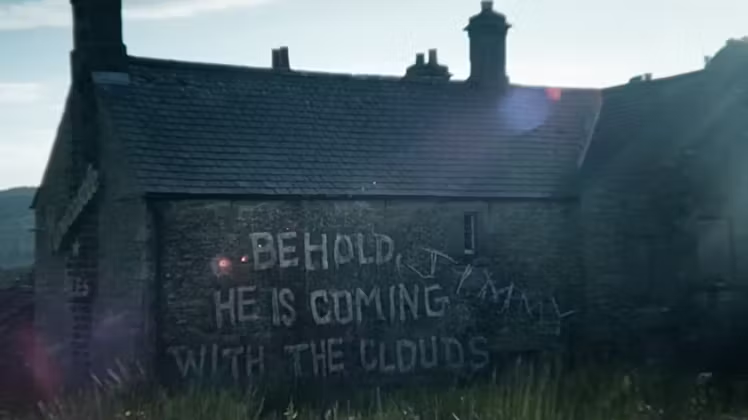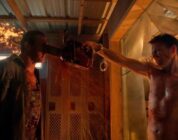Danny Boyle’s highly anticipated sequel, 28 Years Later, continues the original’s themes with a contemplative coming of age story set in the zombie apocalypse.
28 Years Later
Directed By: Danny Boyle
Written By: Alex Garland
Starring: Alfie Williams, Aaron Taylor-Johnson, Jodie Comer, Ralph Fiennes
Release Date: June 20, 2025
Decades after helping to redefine the zombie movie genre as we know it, Danny Boyle is finally back for more. In a lot of ways 28 Years Later feels like the direct follow-up to the original film fans have been waiting for, even though it doesn’t feature any of the previous characters and takes place several years after. It’s an impressive feat that manages to take the franchise forward while simultaneously feeling like we never left. That said, I don’t think it’s going to work for everyone.
By and large, this review is going to be spoiler free as I always do. I will, however, have to dive into some spoilers later on, but I’ll save that for the end and will clearly mark it. For now, feel free to read on even if you haven’t watched it yet!
Setting the Stage
As the title suggests, 28 Years Later picks up the story of the infection in the UK nearly three decades after it initially spread. After other countries were able to successfully fight back the invasion (following the events of 28 Weeks Later), The UK is once again under a strict quarantine with all the survivors left to fend for themselves…Which they have!
The film puts the focus on one particular group of survivors (though implies there are other villages/raiders sprinkled all over), who’ve managed to seclude themselves on a smaller island connected to the mainland via a causeway that comes and goes with the tide. Jamie (Aaron Taylor-Johnson) is taking his 12-year-old son Spike (Alfie Williams) to the mainland for the first time. It’s a sort of right of passage for the members of that village, who train all of the children how to hunt, and kill, infected; a necessary skill to their survival.

It’s interesting to see how these survivors treat the infected now, after so many years of dealing with them. While they’re still considered a threat, and very strict precautions are taken, the infected are simply another fact of life that has to be dealt with. It’s a far cry from the desperate, panicky way people reacted to them before, which makes the moments when things do go wrong (or when those terrifying new “Alphas” show up), all the more stressful.
Anyway, as Spike ventures with his father, bagging his first kills and ultimately being celebrated as a “hero” in the village upon their return, Spike begins having doubts about a few things. Like all kids, he’s entering that point in life we he has to come to grips with the fact that his parents are all too human. They are flawed, can be wrong, and Spike chafes at the idea of things being hidden from him.
Feeling something is off, he decides to take his ailing mother Isla (Jodie Comer), by himself, to the mainland in hopes of finding a real doctor to figure out what’s wrong with her. Along their journey they duo are forced to confront deadly infected (which have some new tricks), a newcomer stranded on the island, and their own thoughts on what life and death really means.

Growing Up in an Age of Zombies
I know this is pretty vague, but so much of what makes this film work, is witnessing them experience this journey. Simply describing it on paper doesn’t really do it justice, and pulls away from the points the movie is making. For the most part, the film’s story focus is on Spike’s coming-of-age story. It hits on many of the familiar tropes common to those kind of stories, but the zombie trappings surrounding it all makes it feel fresh.
The result is a film that tries to get to the heart of what it means to truly live, and die. Thematically, this is directly in line with the original 28 Days Later. Like all great horror films, the ‘monster’ aspect is meant to serve as an allegory for something else within in society. Considering the infection in these films is from the “Rage Virus” it’s pretty obvious where it goes with things.

But even amongst all commentary on the evils of mankind (big and small), the heart of the film is about finding reasons to live beyond mere survival. 28 Years Later dives deeper into this territory, even exploring the opposite side of the coin, death, and how it plays a role in the lives we lead.
Particularly, I was struck by the character of Dr. Ian Kelson (Ralph Fiennes). He’s the man behind the bone temple seen in the trailers (and what the next film is named after). The way he walks Spike through the idea of death, and how it relates to life, is fascinating. Moreso because he chooses to treat both the infected and non-infected equally. Whereas everyone else (understandably) looks at the infected as soulless monsters, Kelson sees them differently. Not necessarily “human” anymore, but still a living thing with thoughts and experiences unique to them.
It’s an encounter that really makes you stop and look at things a bit differently; putting Spike on a path he never once considered. Again, this doesn’t negate the very real threat the infected pose, but it forces Spike—and us as the audience—to re-contextualize our perceptions of them. The overall effect makes for a surprisingly emotional story even among the horror. As my girlfriend said to me after the credits rolled, “I wasn’t planning on crying today. Especially at a horror movie!”

Zombies and Mayhem
For all that, 28 Years Later still brings the goods when it comes to the horror/zombie elements. Even though a number of zombie films have come out in the years since that have taken inspiration from the unique approach Days took, the infected manage to still be uniquely terrifying here.
And I’m not even talking about the evolution some of them have gone through either. Don’t get me wrong, the Alphas are chill inducing, and any time one pops up on screen (even from a distance), my stomach immediately dropped. The film makes sure to remind viewers even the “normal” infected are still scary.
Much of this is conveyed through Boyle’s unique filmmaking style. There’s a frenetic pacing to his action which gets you on the edge of your seat and your heart rate pumping. Even when he choose to slow things down, there’s a lingering tension that never seems to leave. There are some stunning sequences that literally had my jaw aching because I was clenching so hard. Combine that with some wild new ways to showcase some of the individual kills (so cool, by the way), and the film delivers on the zombie action you remember from the original.
The Ending (SPOILERS)
All right, if you want to avoid all spoilers it’s time to turn back. That said, I’m really only going to be talking about the VERY end of the film; the very last scene before the credits roll. So I still won’t be going into spoilers about other aspects of the film’s final act.
Still here? Okay, let’s talk about that kinda bizarre ending.
The final scene of the film sees Spike being chased by a pack of infected, only to be “rescued” by a strange group of flamboyantly dressed survivors, who manage to take down the infected with over the top weapons and a distinct, dramatic flourish. They’re clearly being led by a man named Jimmy, who is the grown-up version of the kid the film actually starts us off with. The opening scene shows the beginning of the outbreak from his perspective…and this is the only time he crops back up.

It’s very obviously a setup for something coming in the next film, The Bone Temple. Honestly, if this were a superhero film, I imagine this sequence as being a post-credit scene. As it stands, it does feel a little odd. Considering all that came before, seeing what feels like the Power Rangers showing up out of nowhere to take on zombies is a jarring shift in tone.
I dug it. It’s offbeat, for sure, but shows another side to how people are surviving on this island. The majority of the film shows us only the one village, and type of survivor, while offering teases about things being different in other parts of the country. With Jimmy and his crew, we get our best look yet at one of these factions.

This just happens to be a group who were likely all orphaned kids from the initial outbreak and ended up essentially having to raise themselves. As such, they still have a kiddish mentality that latched onto the only influence they remember from the “before times” (e.g. kid shows like Power Rangers and such from that era).
From the moment he comes on screen with Spike, Jimmy gives off strong cult leader vibes. I wouldn’t be surprised if he ends up being the overall main villain in the next film. Hell, the body Spike and Jamie come across early in the film left dangling upside down has “Jimmy” carved into his body…

In terms of the tonal shift, I honestly didn’t have many issues with it, and I think it’s because I literally watched Days the evening before. With the original film, the zombie aspects stand out so starkly because they were shocking (especially at the time) and dynamically presented. Because of that, however, I think people forget just how very WEIRD the movie can be.
It waxes poetic, and frequently esoteric in how it presents its story. It’s not a straight-up zombie film (Weeks was, which I suspect is why some struggle with it), and neither is Years. As such, I felt the ending with Jimmy was pretty par for the course in terms of being a Danny Boyle flick.





![Zack Snyder’s ‘Dawn of the Dead’ Still Slays [4K Review] – Dread Central](https://zombiegaming.org/wp-content/uploads/2023/02/kavB3igxUfYY3xNqhLUHjh-568x320-2-178x140.jpg)